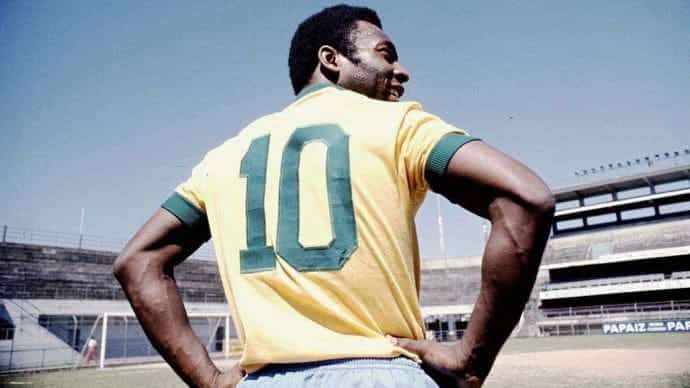In the vast majority of team sports, some numbers, terms, or words have a greater level of importance than others. In soccer, the number 10 is one of the few numbers that carries the same meaning, weight, delight, and praise as any other number.
Everyone who enjoys watching or playing soccer is aware that the number 10 player has been featured on the backs of the jerseys of many of the best soccer players in the annals of the sport’s history.
Keeping this in mind, you may be wondering, “What exactly gives the number 10 that makes it one of the spectacular numbers that stand out with importance in soccer games?” In other words, what is it that gives the number 10 its significance?
In soccer, what is the number 10? What makes the number 10 so significant in soccer? Let’s clarify these questions by using the helpful information that Sportda has provided.
What Is a Number 10 in Soccer?
The position on the field that is linked with the playing number 10 is sometimes referred to as position 10, while other times it refers to the player on the field who is wearing the number 10 on the back of their jersey during play. Rest assured that everything will start to make sense as we go.
For the referee and other players to quickly identify a player, they must stitch a number into the back of their shirt. These numbers often range from one to eleven, although they may be any number.
It is common practice to assign the number 10 to the player who occupies the position on the pitch that is directly behind the forwards and in front of the midfielders. This may mean that you will occasionally hear someone refer to the number 10 during a game, but the person who replies will not be wearing the number 10 on their back; rather, they will be wearing a different number on their back. This is because cooperation can mean that this happens.
This may leave you bewildered and wondering: how exactly do we know who is number 10? Don’t be concerned; as we continue, everything will become clearer to you.
Why Is a No. 10 Jersey Assumed to Be Significant?

The players who wear the number 10 in soccer are mostly responsible for the number’s notoriety.
Many players throughout the history of soccer have worn this number, and many of them have gone on to do remarkable things. The improvement in their reputation also contributes to the increased significance of the number 10 in football.
Many of the best players in the history of the sport, like Pele, Messi, and Maradona, have worn the number 10 at the peak of their careers while wearing the shirt it was assigned to them.
More and more people feel that the number 10 has a special significance and mystical power in soccer, and this may be because many exceptional players have achieved success while wearing the number 10. Since only the best soccer players typically wear the number 10 jerseys, they received constant reinforcement.
The significance of this number affects even young children who have a keen interest in soccer. Many of them play against their buddies while wearing the number 10 jersey either because of the brilliance it signifies or because they just want to mimic the notable number 10 players that they adore.
Number 10: A Quick Review of History

It is necessary to go back in time a little to understand why the number 10 is given such importance in soccer; this may be done by looking at historical records. We are going to get inside our time machine and investigate the reason why soccer players wear numbers, to begin with.
We go back in time, more than a century, to 1911 in Australia. During this period, there was a game played between Sydney Leichhardt and HMS Powerful, and it was the first time in documented history that a soccer team competed while wearing numbers on their shirts. HMS Powerful was the winning team. After another year had passed, the New South Wales government made the practice of numbering soccer players a requirement.
Following this, the next known instance of numbers being stitched into jerseys occurred on March 23rd, 1914. At Stamford Bridge in London, a match between an amateur team of players known as the English Wanderers and Corinthians took place.
Argentina, a nation located in South America, was the first team to wear numbered jerseys. It happened in 1923, as the Scottish Team Third Lanark was traveling through South America. Both teams participated in a friendly competition and assigned numbers 1-11 to their players.
On March 30, 1924, the Fall River Marksmen and the St. Louis Vesper Buick soccer teams competed in the National Challenge Cup. During this match, the players wore numbered jerseys for the first time in the history of the sport in the United States. Nevertheless, the only team that wore numbered jerseys was the home squad.
Even though numbered jerseys have been present for more than a century, their widespread use did not begin until the first part of the 20th century. However, the history behind the number 10 shirt is a great deal more specific, despite the fact that it is not all that, unlike the history behind the other numbers worn by soccer players.
Originally, a corresponding number served as a means of identification for distinct spots on the fields. A number between 1 and 11 was assigned to each slot. The location on the field that a player occupied, as well as their position, would be deduced from this number.
If they were number one, you would know that they are the goalkeeper; if they were number nine, you would know that they are the center forward; and if they were number eight, you would know that they are the central midfielder. Before we go any further, let’s take a quick look at the different postures.
The game of soccer benefited greatly from the implementation of the numbering system, which was highly convenient. The first reason why it was beneficial was that it was helpful in teaching. When describing strategies to their players, the coaches were then able to refer to a certain number of the fields, and everyone was aware of what the position that was being spoken about was.
It was also very helpful for the players on the team, as it assisted them in correctly identifying where they were supposed to be playing. Additionally, they were able to look around them and at the numbers on the backs of their fellow player’s jerseys to determine where each other player was, as well as where a person was, which contributed to more efficient teamwork.
What is the role of the No. 10 soccer player?

Let’s analyze the function of the soccer number 10 position, shall we? In soccer, the number 10 position is the one that is responsible for providing possibilities for the team to score goals. This may be done by making sharp passes, creating space for other teammates, or occasionally, when the going gets tough, by scoring goals themselves as well. This function is often referred to as the playmaker. When it comes to the way that they direct the play of the group, they are comparable to a conductor of an ensemble in many ways.
They often move the ball to spots where it may have the most significant effect on the game. To be successful on the pitch, they require a skill sometimes referred to as “soccer brain,” which is simply skill and knowledge for the game, as well as education in foresight. An excellent 10 will be able to think on their feet and come up with novel solutions.
The number ten is typically the team’s most talented and inventive player; in addition to passing, shooting, and dribbling well, they must be able to create space for themselves and their teammates, cross the ball effectively, and maintain possession of the ball in a flash.
Since they are offensive players, their initial thought after gaining possession of the ball should be to determine whether or not they can move the ball into a more advanced and beneficial position. They will attempt to contribute to the formation of a chance for the team to score goals as well as score a goal for themselves. Some of the most famous number 10s are believed to be very skilled and excellent at what they do since they not only create goals but also score frequently during their games and matches. This is one of the reasons why they are regarded as being among the best at what they do.
They need technical skills when they come up against the ball. They must have the ability to execute their vision, whether it’s a pass that has already been performed or an action that might open up the defense of the opponent. They need to be able to foresee it, direct it, and bring it to fruition.
You may have heard people refer to former number 10s as almost having the ball “glued to their feet” or “dancing with the ball,” indicating that they have a talent for ball control. These players typically have above-average technical ability that lets them maintain a hold on to the ball for as long as they need to without being tackled very easily.
These athletes are referred to as playmakers, and there is a large gap between elite players and deep-lying playmakers. Holding midfielders with an eye for attacking plays are called “deep-lying playmakers,” and they tend to focus on offensive rather than defensive ball abilities.
Who are the best players to wear number 10?
Michel Platini
Platini was a phenomenal ballplayer and a top pick for his era’s all-star team. From long range and the penalty spot, he was unstoppable as a dead-ball expert. He had incredible speed for his size and could have been used in any offensive position. He was another creative force that consistently outwitted his opponents.
He was not physically strong and did not seem to be an outstanding athlete, but he always appeared ready to surprise and could defeat anybody who placed the ball at his feet.
Lionel Messi

One of the best soccer players in the world is Lionel Messi. Messi obliterated the Barcelona record books, which is a significant feat when you consider all the incredible plays that came before him, even though not many people may still appreciate the Argentine brilliance over some of the other great soccer players. His age was 24 years old when he was named the club’s all-time leading scorer. After Ronaldinho’s departure from the club, Ronaldinho gave Messi his No. 10 jersey to wear. Messi has said on several occasions that Ronaldinho was the player most instrumental in easing his transition into the first team.
He also holds the record for the most assists in La Liga history, and he consistently came up with creative methods to score without ever doing so at his team’s request. It’s incredible that Messi is still so young and has accomplished so much, with eight league championships, four Champions League trophies, five Ballon d’Ors, and even more records than Madonna.
Diego Maradona
What you make of your age and location will determine how you feel about Diego Maradona. In England, he plays the villain, but in his native Buenos Aires, he is a folk hero after his performance against the Three Lions.
When he got going fast on the field, his bulky, sturdy body made him a nightmare to catch. He could twist and spin past many players in the blink of an eye due to his low center of gravity. It nearly seemed like he would have won the 1986 World Cup all by himself, facing up against the competition. He had incredible dribbling skills, magnetic tight control, and a surprising burst of speed. He exemplified all that is admirable in a number 10, and then more.
FAQs
Who is the best No 10 in football history?
Pele. Although he passed away in December 2022, legendary Brazilian footballer Pele will always be regarded as the game’s greatest number 10. Edson is also the first player in history to win three World Cups.
Why did Messi choose number 10?
After winning no titles in 2007/08, Barcelona fired Ronaldinho. After he departed from the club, Ronaldinho gave Messi his No. 10 jersey. Messi always thought Ronaldinho helped him adapt to the main team.
What is the number 10 in soccer?
10 is a slashing forward who can fill in anywhere from center midfield to the front lines. They often catch passes in the area ‘between the lines’, between the midfield and defense of the opposing team.
How do you get a good 10 in soccer?
They need to be positive and assertive in their movement as they seek to create space for themselves, receive the ball, and make things happen, which means they need to be very comfortable on the ball. Possess the ability to pass and catch with equal ease.


